Olivenza
Olivenza (Spanish: [oliˈβenθa]) or Olivença (Portuguese: [oliˈvẽsɐ]) is a town situated on an historically disputed section of the Portugal–Spain border. Its territory is administered by Spain as a municipality belonging to the province of Badajoz, and to the wider autonomous community of Extremadura.
Olivenza
| |
|---|---|
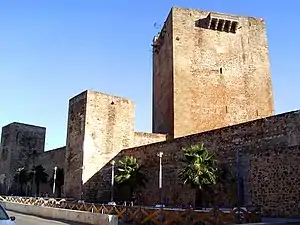 Castle of Olivenza | |
.svg.png.webp) Flag  Coat of arms | |

| |
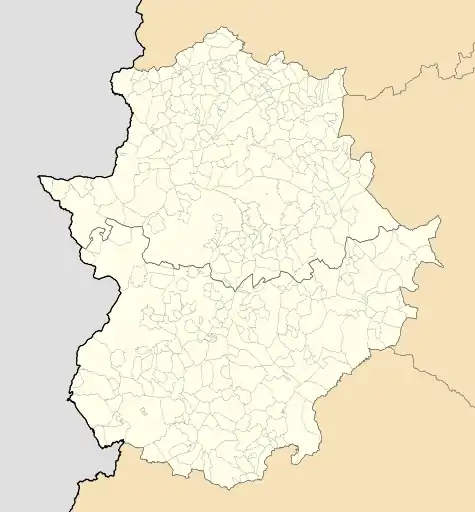 Olivenza Location in Spain  Olivenza Olivenza (Spain) | |
| Coordinates: 38°41′9″N 7°6′3″W | |
| Country | Spain |
| Autonomous community | Extremadura |
| Province | Badajoz |
| Government | |
| • Mayor | Manuel José González Andrade (PSOE) |
| Area | |
| • Total | 430.1 km2 (166.1 sq mi) |
| Elevation | 327 m (1,073 ft) |
| Population (2018)[1] | |
| • Total | 11,986 |
| • Density | 28/km2 (72/sq mi) |
| Time zone | UTC+1 (CET) |
| • Summer (DST) | UTC+2 (CEST) |
| Postal code | 06100 |
| Website | Town Hall (in Spanish) |
The town of Olivença was under Portuguese sovereignty between 1297 (Treaty of Alcañices) and 1801, when it was invaded by the Spanish during the War of the Oranges and ceded to Spain that year under the Treaty of Badajoz. Spain has since administered the territory (now split into two municipalities, Olivenza and also Táliga), whilst Portugal invokes the self-revocation of the Treaty of Badajoz, plus the Treaty of Vienna of 1815, to claim the return of the territory. In spite of the territorial dispute between Portugal and Spain, the issue has not been a sensitive matter in the relations between these two countries.[2][3] Olivenza and other neighbouring Spanish (La Codosera, Alburquerque and Badajoz) and Portuguese (Arronches, Campo Maior, Estremoz, Portalegre and Elvas) towns reached an agreement in 2008 to create a euroregion.[4][5]
Geography

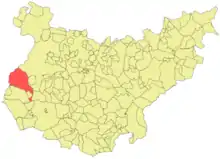

Olivenza is located on the left (east) bank of the Guadiana river, at an equal distance of 24 kilometres (15 miles) south of Elvas in Portugal and Badajoz in Spain. The territory is triangular, with a smaller side resting on the Guadiana and the opposite vertex entering south-east and surrounded by Spanish territory. By an agreement between Spain and Portugal, the left bank of the river was recognized as being Portuguese territory (to a non-defined width, though), which sets the de facto border in that area. Besides the town, the municipality of Olivenza includes six villages: San Francisco (Portuguese: São Francisco), San Rafael (São Rafael), Villarreal (Vila Real), Santo Domingo de Guzman (São Domingos de Gusmão), San Benito de la Contienda (São Bento da Contenda), and San Jorge de Alor (São Jorge da Lor). Another village, Táliga, was detached to become the seat of a separate municipality in 1850.
Total population is 10,762 (2002), of which 8,274 live in Olivenza. The total area is 750 square kilometres (290 sq mi). Like the surrounding regions, population density is low, at 11 inhabitants per km².
Some monuments include the church of Saint Mary of the Castle (Spanish: Iglesia de Santa María del Castillo, Portuguese: Igreja de Santa Maria do Castelo), Holy Ghost Chapel (Capilla del Espíritu Santo, Capela do Espírito Santo), Saint Mary Magdalene Church (Iglesia de Santa María Magdalena, Igreja de Santa Maria Madalena, considered a masterwork of Portuguese Manueline architecture), Saint John of God Monastery (Monasterio de San Juan de Dios, Mosteiro de São João de Deus), the keep (torre del homenaje, torre de menagem), and the ruins of the Our Lady of Help Bridge (Puente de Nuestra Señora de Ayuda, Ponte de Nossa Senhora da Ajuda, destroyed in 1709 and never rebuilt).
There are still traces of Portuguese culture and language in the people, although the younger generations speak Spanish only. At the beginning of the 1940s the city was reportedly mainly Portuguese-speaking, but after the 1940s a language shift towards Spanish took place.
Since 2014, more than 1,000 inhabitants have asked for a double citizenship. As of 2018, 1,500 people (about 8% of the town's demographics) speak Portuguese.[6]
Chronology

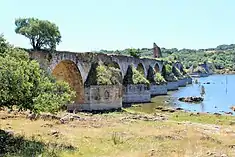
.jpg.webp)

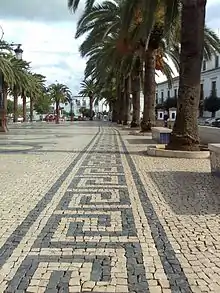
- 1170 – Olivenza region falls for the first time into Portuguese hands during the conquests of Afonso Henriques, the first king of Portugal.
- 1189 – Muslims retake the region.
- 1230 – The Olivenza area (as part of the Badajoz surroundings) is taken from the Muslims by King Alfonso IX of León.[7]
- 1259 – The Knights Templar already established in the nearby town of Alconchel, create the first settlement that can be identified as the origin of the town of Olivenza. The Templars built the first castle and church of the town.[7]
- 1278 – Olivenza and the surrounding area is granted by King Alfonso X of Castile and León to the Bishopric and Council of Badajoz, taking it back from the Knights Templar.[7]
- 1297 – After the critical situation created in Castile with the death of King Sancho IV, King Dinis of Portugal forces King Ferdinand IV to sign the Treaty of Alcañices (1297) and cede, amongst other possessions, Olivenza to Portugal.[8]
- 1298 – King Denis of Portugal grants Olivenza a foral (charter), and new city walls are built.
- 1510 – King Manuel I of Portugal renews the town charter and orders the building of fortifications and the Olivença Bridge over the Guadiana River (Ponte de Olivença, later known as Ponte de Nossa Senhora da Ajuda (Our Lady of Help Bridge) or, simply as Ajuda bridge), on the road to Elvas. Construction of Santa Maria Madalena Church begins. This church would be the residence of the Bishop of Ceuta for many years.
- 1668 – Treaty of Lisbon between Spain and Portugal reaffirms the borders defined in the Treaty of Alcanizes of 1297.
- 1709 – During the War of the Spanish Succession, the Ponte da Ajuda Bridge is destroyed by Spanish forces. Its ruins remain until today.
- 1801
- 29 January 1801 – France, allied to Spain, demands Portugal, British ally since the Anglo-Portuguese Treaty of 1373, to enter into an alliance with France in the war against Britain. Portugal refuses.
- 27 February 1801 – The brief War of the Oranges begins, with the French troops marching on Portugal, later followed by Spanish troops.
- 20 May 1801 – Spanish troops occupy, among other towns, Olivenza.[9]
- 6 June 1801 – The war is over with the simultaneous signing of two treaties in Badajoz, Spain, the first between France and Portugal, and the second between Spain and Portugal. As both treaties mention each other and share common clauses, they are frequently referred to as just the Treaty of Badajoz. Under one of the terms of the Treaty, Spain gives back all the occupied towns except those on the left bank of the Guadiana river (the territory of Olivenza),[9] which are ceded by Portugal to Spain, including its inhabitants, on a 'perpetual' basis. The Treaty also stipulates that the breach of any of its articles leads to its cancellation.[10]
- 29 September 1801 – The treaty is signed again, this time in Madrid, with slight modifications demanded by France, but not affecting the stipulated for Olivenza.[9]
- 1805
- 26 January 1805 – The Portuguese currency is forbidden.
- 20 February 1805 – Teaching in Portuguese is forbidden.
- 14 August 1805 – Adoption of the Spanish language in city hall documents.
- 1807
- October – Treaty of Fontainebleau (1807) between Spain and France dividing Portugal and all Portuguese dominions between them.
- November – French and Spanish troops again march over Portugal, in the Peninsular War.
- 1808
- 1809
- July – Portugal presents to the Junta Central, in Seville, an official order of restitution of the territory of Olivenza.
- 1810
- 19 February 1810 – Treaty of alliance and friendship between Portugal and Britain, whereby Great Britain pledges to help Portugal to regain possession of Olivenza, in turn receiving the exploration of the Portuguese establishments of Bissau and Cacheu for a period of 50 years.
- Portugal starts negotiating a treaty with the Regency Council of Spain, whereby Olivenza should be given back to Portugal.
- 1811
- 15 April 1811 – Beresford, a British marshall with the rank of Head General of the Portuguese Army, briefly retakes Olivenza.[9]
- 1813
- 19 May 1813 – The remaining Portuguese language private schools are closed by the Spanish authorities.
- 1814
- 30 May 1814 – The Treaty of Paris between France and the allied countries (including Portugal) includes a provision declaring the 1801 treaties of Badajoz and Madrid null and void. Spain is not a part of this agreement.
- 1815
- 9 June 1815 – The Portuguese delegation to the Congress of Vienna, led by Pedro de Sousa Holstein, succeeds in including article 105 in the Final Act (aka the Treaty of Vienna), stating that the winning countries are to endeavour with the mightiest conciliatory effort to return Olivenza to Portuguese authority. The Spanish representative to the Congress, Pedro Gomes Labrador, refuses to sign the Treaty, registering a protest against several of the Congress resolutions, including article 105.
- 27 October 1815 – Expecting the quick restitution of Olivenza, Prince Regent John nominates José Luiz de Sousa as Plenipotentiary.
- 29 January 1817 – Portugal occupies Uruguay due to rebel threats against Brasil.
- 7 May 1817 – Spain finally signs the Treaty of Vienna, since, in the Spanish interpretation, the text is not mandatory on demanding Spain to return Olivenza to Portugal. However, the text clearly states that all the signatary winning powers promise to take all efforts to make sure that Olivenza is returned to Portugal.
- 1818–1819 – Spain and Portugal, with the mediation of France, England, Russia and Austria, negotiate in the Conference of Paris toward a peaceful restitution of Uruguay to Spain. Spain accepts the terms of an agreement proposed by the mediators but due to internal problems and the Liberal Revolution in 1820, actions never took place.
- 7 November 1820 – Spanish authorities forbade the use of private teaching in Portuguese.
- 1821 – Portugal annexes Uruguay. In reaction, Spain withdraws from the Olivenza talks.
- 1840 – The Portuguese language is forbidden in the territory of Olivenza, including inside churches.
- 1850 – The village of Táliga is separated to form its own municipality.
- 1858 – Isabel II of Spain grants the title of City (Ciudad) to Olivenza.
- 29 September 1864 – The Treaty of Lisbon (1864) between Portugal and Spain is signed, demarcating the border from the estuary of the Minho river, on the far North, to the confluence of the Caya River with the Guadiana river, just north of Olivenza. The demarcation of the border is not pursued further because of the situation of Olivenza.
- 1918/1919 – With the end of World War I, the Portuguese government studies the possibility of taking the situation of Olivenza to the Paris Peace Conference. However, as Spain had not participated in the War, the intervention of the international community in this issue is not possible.
- 29 June 1926 – Portugal and Spain sign the Convention of Limits (1926) an agreement demarcating the border from the confluence of Ribeira de Cuncos with the Guadiana, just south of Olivenza, to the estuary of the Guadiana, on the far South. The border between Portugal and Spain from the confluence of the Caya river to the confluence of the Cuncos is not demarcated and remains so nowadays, with the Guadiana being the de facto border.
- 1936–1939 – During the Spanish Civil War, Portuguese Colonel Rodrigo Pereira Botelho volunteers to occupy Olivenza. The 8th Portuguese Regiment, stationed in nearby Elvas, prepares to take Olivenza but is ordered not to.
- 15 August 1938 – The Pro-Olivenza Society (Sociedade Pró-Olivença) is founded, the first of a number of pressure groups established to advance the cause of Olivenza in Portugal.
- 1954 – Oliventine children are no longer allowed to take free holidays in the Portuguese seaside resort "Colónia Balnear Infantil d'O Século", managed by a newspaper owned charity.
- 24 January 1967 – The Portuguese government declares the Ponte da Ajuda Bridge a National Heritage Monument.
- 1968 – A covenant between Portugal and Spain on exploitation of hydraulic resources in the frontier rivers is signed. All frontier rivers (including the non-demarcated section in the Guadiana river) are covered, distributing the hydraulic exploitation between both countries. The hydraulic exploitation of the non-demarcated section in the Guadiana river is assigned to Portugal (in the same way as the rights on hydraulic exploitation over other frontier rivers are assigned either to Portugal or to Spain). The only difference between this section and the rest is that the term "international" is omitted (all the sections are named "international section" but the non-demarcated one in the Guadiana river).[11]
- 1977 – A Treaty of Friendship and Cooperation between Spain and Portugal is signed, with no mention to the Olivenza claim.[12]
- 1981 – Former prime-minister of Portugal, Admiral Pinheiro de Azevedo publishes a book on Olivenza and visits the town, leading Spain to send a contingent of the Civil Guard (Guardia Civil) to prevent any confrontation.
- 1990
- In an Iberian Summit, the prime ministers of Portugal and Spain sign a covenant for the joint effort to preserve the Ponte da Ajuda Bridge, as well as the construction of a new bridge alongside it, also as a joint effort.
- Elvas and Olivenza became friendship towns.
- 1994, November – After internal criticism that the agreement of 1990 would mean the recognition of the de facto border by the government of Portugal, the agreement is modified in another Iberian Summit. Portugal is now in full charge of constructing the new bridge and preserving the old bridge, therefore not putting the Portuguese claim to the territory of Olivenza at stake.
- March 1995 – The Portuguese government sends its Spanish counterpart a study on the effects of the construction of the Alqueva Dam on Spanish territory. Information on Olivenza is not included. Later, Portugal sends further information, including data on Olivenza, under the title "Territory of Spain and Olivenza".
- October 1999 – The Spanish police stop preservation works being undertaken by the Portuguese on the old Ponte da Ajuda Bridge on the left bank (Spanish side) of the Guadiana river. The Portuguese had been working on that side of the bridge without Spanish permits assuming that the left bank-side of the Guadiana river belonged to Portugal, according to the 1968 covenant. In subsequent events, a Portuguese court order prevents Spain from taking over the works.
- 11 November 2000 – The new Olivenza Bridge, constructed by Portugal, is inaugurated.
- 2003
- Spain restarts work on the old bridge, under protest from the Portuguese government.
- 2004
- 25 June 2004 – The Portuguese parliament raises the issue of Olivenza and exhorts the Minister of Foreign Affairs to try to solve the question, in a friendly and cooperative way, with Spain and the people of Olivenza, within the European Union.
- 4 September 2004 – The Portuguese Minister of Foreign Affairs, Antonio Martins da Cruz states that the Olivenza issue "is frozen".[13][14]
- 7 September 2004 – The Government of the autonomous community of Extremadura declares the old Ponte da Ajuda Bridge a Heritage Monument.[15]
- 2007 – Guillermo Fernandez Vara, who was born in Olivenza, is elected president of Extremadura.
- 2010 – The ancient Portuguese street names, that were removed in the first half of the 20th century, return to the historical city centre of Olivença.[16]
- December 2014 – Portuguesen ationality is given to 80 residents of Olivenza, after their formal request. Other 90 similar requests from residents of Olivenza are received by the Portuguese authorities.[17] In the beginning of 2018, the number of residents with Portuguese nationality is around 800.[18]
- 1 December 2018 - The Olivenza Marching Band participates in the Portuguese bands parade in Lisbon, in commemoration of the 1640 Restoration of the Portuguese Independence.
Claims of sovereignty
Portugal does not recognise Spanish sovereignty over the territory, based on its interpretation of the rulings of the 1815 Congress of Vienna. Spain accepted the Treaty on 7 May 1817; however, Olivença and its surroundings were never returned to Portuguese control and this question remains unresolved[19] and Portugal holds a claim over it.[19] Olivenza was under Portuguese sovereignty from 1297. During the War of the Oranges, French and Spanish troops, under the command of Manuel de Godoy, took the town on May 20, 1801. In the aftermath of that conflict, the Treaty of Badajoz was signed, with the Olivenza territory remaining a part of Spain.
Spain claims ‘de jure’ sovereignty over Olivenza on the grounds that the Treaty of Badajoz still stands and has never been revoked, thus making the case that the border between the two countries in the region of Olivenza should be demarcated as said by the treaty.
Portugal claims de jure sovereignty over Olivenza on the grounds of the cancellation of the Treaty of Badajoz, since it was revoked by its own terms. The breach of any of its articles would lead to its cancellation, and that happened when Spain invaded Portugal in the Peninsular War of 1807. Portugal further bases its case on Article 105 of the Treaty of Vienna of 1815 (which Spain signed in 1817) that states that the winning countries are "committed to employ the mightiest conciliatory effort to return Olivenza to Portuguese authority" and that the winning countries "recognize that the return of Olivenza and its territories must be done".[20] Thus, the border between the two countries in the region of Olivenza should be demarcated by the Treaty of Alcanizes of 1297.
Spain interprets Article 105 as not being mandatory on demanding Spain to return Olivenza to Portugal, thus not revoking the Treaty of Badajoz.
Portugal has never made a formal claim to the territory after the Treaty of Vienna, but neither has it directly acknowledged Spanish sovereignty over Olivenza.
Portuguese military maps do not show the border at that area, implying it to be undefined. Also, the latest road connection between Olivenza and Portugal (entirely paid by the Portuguese state,[21] although it involved the building of a bridge over the Guadiana, an international river) has no indication of the Portuguese border, again implying an undefined status.
There is no research on the opinion of the inhabitants of Olivenza about their status. Spanish public opinion is not generally aware of the Portuguese claim on Olivenza. On the other hand, awareness in Portugal has been increasing under the efforts of pressure groups to have the question raised and debated in public.[22][23][24]
Famous people born in Olivenza
- Guillermo Fernández Vara (1958) – Spanish politician, president of Extremadura.
- Pedro da Fonseca (?–1422) – Portuguese cardinal.
- Paulo da Gama (1465-1499), Vasco da Gama's elder brother, commander of São Rafael in the discovery of the route to India.
- Vicente Lusitano (c. 1461 – c. 1561) – Portuguese composer and music theoretician.
- Tomás Romero de Castilla (1833–1910) – Spanish theologian, founder of the Museo Arqueológico Provincial de Badajoz.
References
- Municipal Register of Spain 2018. National Statistics Institute.
- Portugal desmiente a la CIA y niega que haya un conflicto por Olivenza Archived 2011-07-26 at the Wayback Machine (in Spanish)
- Martins da Cruz Afirma Que a Questão de Olivença "Está Congelada" (in Portuguese)
- Europacto en la frontera hispano-lusa Archived 2011-07-26 at the Wayback Machine (in Spanish)
- Euroregião e Declaração de Olivença (in Portuguese)
- "Olivença apaixona-se e zanga-se em português". Público. Retrieved 29 January 2021.
- Templespaña (2012). Gran Guía de la España Templaria (in Spanish). Santillana. ISBN 978-8403012073.
- Margarida Garcez Ventura, A Definição das Fronteiras, Ed. Quidnovi, Matosinhos/Lisbon, 2007, ISBN 978-972-8998-85-1
- António Pedro Vicente, Guerra Peninsular, Ed. Quidnovi, Matosinhos/Lisbon, 2007, ISBN 978-972-8998-86-8
- in António Ventura, Guerra das Laranjas, Ed. Quidnovi, Matosinhos/Lisbon, 2008, ISBN 978-989-628-075-8, the text of the Treaty of Badajoz: "[Preamble] [...] dois Tratados, sem que na parte essencial seja mais do que um, pois que a Garantia é recíproca, e não haverá validade em alguns dos dois, quando venha a verificar-se a infracção em qualquer dos Artigos, que neles se expressam. [...] Artigo I: Haverá Paz [...] entre Sua Alteza Real o Príncipe Regente de Portugal, e dos Algarves, e Sua Majestade Católica El-Rei de Espanha, assim por mar, como por terra em toda a extensão dos seus reinos [...]. Artigo III: Sua Majestade Católica [...] conservará em qualidade de Conquista para unir perpetuamente aos seus Domínios, e Vassalos, a Praça de Olivença, seu Território, e Povos desde o Guadiana; de sorte que este Rio seja o limite dos respectivos Reinos, naquela parte que unicamente toca ao sobredito Território de Olivença. [...] Artigo IX: Sua Majestade Católica se obriga a Garantir a Sua Alteza Real o Príncipe Regente de Portugal a inteira conservação dos Seus Estados, e Domínios sem a menor excepção, ou reserva. [...]"
- Instrumento de ratificación del Convenio y Protocolo adicional entre España y Portugal para regular el uso y aprovechamiento hidráulico de los tramos internacionales de los ríos Limia, Miño, Tajo, Guadiana y Chanza y sus afluentes, firmado en Madrid el 29 de mayo de 1968.. Article III states:
El aprovechamiento hidráulico de las siguientes zonas de los tramos internacionales de los restantes ríos mencionados en el artículo primero será distribuido entre España y Portugal de la forma siguiente:
In the same article, sections A and B are assigned to Portugal, while C, D and F are assigned to Spain.
[...]
E) Se reserva a Portugal la utilización de todo el tramo del río Guadiana entre los puntos de confluencia de éste con los ríos Caya y Cuncos, incluyendo los correspondientes desniveles de los afluentes en el tramo. - Instrumento de ratificacion de España del Tratado de Amistad y Cooperacion entre España y Portugal, hecho en Madrid el dia 22 de noviembre de 1977 (in Spanish).
- Martins da Cruz Afirma Que a Questão de Olivença "Está Congelada" (in Portuguese), Público.
- «Una cuestión congelada», según Portugal (in Spanish), ABC, September 15, 2004
- RESOLUCIÓN de 6 de septiembre de 2004, de la Consejería de Cultura, por la que se incoa expediente de declaración de bien de interés cultural, para el puente de Ajuda en la localidad de Olivenza (Badajoz) Archived 2006-10-21 at the Wayback Machine (in Spanish).
- "Archived copy" (in Portuguese). Archived from the original on 2010-06-12. Retrieved 2010-10-31.CS1 maint: archived copy as title (link)
- https://diariodigital.sapo.pt/news.asp?id_news=753161 Archived 2016-12-27 at the Wayback Machine Dezenas de habitantes de Olivença pedem e obtêm nacionalidade portuguesa (in Portuguese)
- "Afeto cultural e oportunidade de emprego levam oliventinos à dupla nacionalidade". 2018-03-05.
- Rongxing Guo, Territorial Disputes and Resource Management: A Global Handbook, Nova Science Publisher/New York, 2007. page 199
- "Europe :: Spain — the World Factbook - Central Intelligence Agency".
- "Ionline".
- Jefferies, Anthony (19 August 2006). "The best of both worlds". Daily Telegraph. Telegraph Media Group. Retrieved 19 February 2010.
- Mora, Miguel (4 December 2000). "La eterna disputa de Olivenza-Olivença". El País (in Spanish). Ediciones El País, S.L. Retrieved 19 February 2010.
- Caetano, Filipe (18 January 2008). "Cimeira Ibérica: Olivença ainda é questão?". IOL Diário (in Portuguese). Media Capital Multimedia. Retrieved 19 February 2010.
External links
| Wikimedia Commons has media related to Olivenza. |
- CIA World Factbook reference to Olivenza in the "Disputes – international" section on the Spain page
- (in Portuguese) Official Map of Portugal with Olivenza IGEOE
- Official Portuguese statements GAO
- CIA World Factbook reference to Olivença in the "Disputes – international" section on the Portugal page
- (in Spanish) Olivenza in the official website of the Province of Badajoz
- (in Spanish) Olivenza in the official website for Tourism in the Region of Extremadura
- Website for Portuguese pressure group "Group of Friends of Olivenza"
- Portuguese, Spanish Website for Oliventino cultural group Alemguadiana